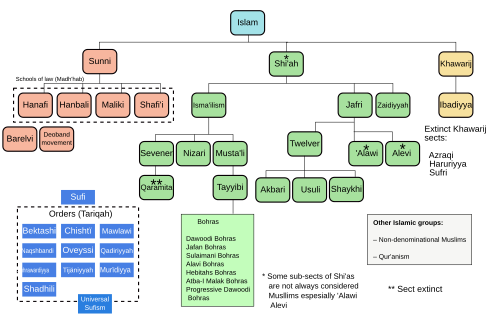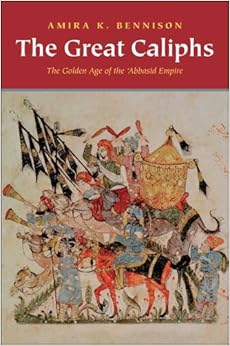I have just finished reading The Great Caliphs: The Golden Age of the 'Abbasid Empire by Amira K. Bennison. There is an earlier post on the book.
The fifth chapter of the book focuses on Islamic knowledge during the time of the Abbasid, Umayyad and Fatimid Caliphates. The Caliphates began in the European "Dark Ages", and were for a time the repository of much of the world's advanced knowledge.
Of course, the Koran is the key source of Islamic knowledge, regarded as the revelation by God to the Prophet Mohammed. However, you have to know how to read to understand the Koran, and early in the days after Mohammed there was an effort to translate books that would help in the understanding of the Koran. (Think of the reading comprehension tests we give to school kids who "already know how to read" to test how much they understand of what they do read. Think of the task of the Supreme Court to figure out the intent of laws and the intent of the Constitution, and thus whether the law is in contravention of the Constitution.)
In addition, especially in the early days of Islam, there was an effort to document the practices of Mohammed and the Muslims he gathered around him as well well as to record his teachings (the Sunna and the Hadiths). Bennison describes a process in which scholars first sought to record the things that could be remembered by people who lived around Mohammed and who actually heard him speak, then the memories of people who had the information from direct sources, and ultimately from sources further removed. This then led to a work of scholarship to identify the sources and statements that were truly reliable and to screen out those which were likely to have been added in error. Bennison goes on to describe the further interest in the tools of logic and analysis that had been earlier developed and were available from Latin, Greek and other sources (involvinging translation into Arabic). This, according to Bennison was followed by elaboration of several major schools of jurisprudence in Islamic Law. (Remember, that Islam in western terms is both a religion and a system of government, with Islamic law governing what most Americans would regard as aspects of secular behavior as well as religious behavior.)
Overview of the major schools and branches of Islam
 |
| Source: Wikipedia |
The book goes on to discuss the major effort of translation that was undertaken in the Caliphates. Geometry and mathematical texts from other cultures were translated to support the work of government officials (e.g. taxation) and those constructing canals and other "engineering" and building works. Astronomical texts were translated to support the work of Islamic astronomers who made observations and updated calendars. There was also translation of astrological works and other works which we would now see as pseudo- or pre-scientific.
 |
| Al-Farabi statue at al-Farabi Kazakh National University |
Bennison goes on to describe the original work in philosophy, theology and science of Arab scholars of the time, especially those who synthesized large bodies of knowledge, some of whom became known in the west (e.g. Ibn Rušd or Averroes, ibn Sīnā or Avicenna and al-Farabi) While hundreds of these early Islamic savants are known to history, their numbers are tiny compared to the global scientific and scholarly workforce today. On the other hand, these men saved much of classical knowledge, storing it in numerous libraries during the "dark ages" of Western Europe so that it became available to Renaissance scholars when the rest of the world was ready to resume the march of knowledge.
This chapter was hard to read in that it identified a lot of books by authors I did not know, with only the sketchiest description of their contents. The chapter made the point that there was an intellectual explosion at the time, but left me unsure of its content and somewhat confused.
I also wondered about the practical technologies. I assume that there was a spread of agricultural technologies; as Jared Diamond points out, these could spread more easily east-west in the Eurasian land mass than in other regions of the world. and that spread contributed to economic development. Textiles were perhaps the leading industrial product of the time; was there a development and spread of textile technology via the trade routes of the Caliphates? How about the building technologies of the Romans, and especially their road building abilities, How about the qanat technologies of the Persians and other irrigation technologies; were Egyptian water raising technologies spread or the Archimedes' screw. Was there development of camel-based transportation technology and routes that enabled the Berbers and Arabs to extend trade and Islam through the Sahara? The book points out that the Arab-Muslims early developed naval power in the Mediterranean and sea trade in the Indian Ocean, but how did ship building technology progress in the time of the Caliphates? Geography must have progressed given the travel and trade of the time, but the work of al-Idrisi is only mentioned in passing late in the book. Perhaps I am simply recognizing a limitation of the sources from the historic record; perhaps people didn't write about such things or the records did not survive.
The final brief chapter of the book deals with the legacy of the Caliphates. As happens with empires, they grow and then decline. The Caliphates were created by Arab-Islamic conquerors. The ethnic Turkish military that the Abbasid Caliphs eventually depended upon became the basis of the Ottoman empire. Mongols took over much of the eastern Abbasid empire, becoming Muslims themselves in the process; eventually the last Caliph was killed by a Mongol ruler. Christians reclaimed Spain and Sicily from Arab-Muslim control. Thus, one can see political legacies of the Caliphates even as the Arab-Muslim political control of the huge region of its former empire declined.
Perhaps more important was the intellectual legacy. As Christians reconquered Spain, for a while there was a vibrant community of Arabs, Jews and Christians who translated great books from Arabic into Latin (see The Ornament of the World: How Muslims, Jews and Christians Created a Culture of Tolerance in Medieval Spain by Maria Rosa Menocal). The Arab learning may too have stimulated a rebirth of interest in ancient knowledge and the development of new knowledge in Byzantium, and knowledge from the Caliphates found its way into humanist hands triggering and fueling the Renaissance.
I found this book of considerable value in broadening my view of early Islamic history and the debt that the world owes to the Caliphates. I would have liked to see a glossary, and perhaps more visual aids but that is quibbling with the author's choices which overall led to a short book full of information that many readers from the West will not have previously known.


No comments:
Post a Comment